The 10 Most Insane Old School Dungeons & Dragons Rules
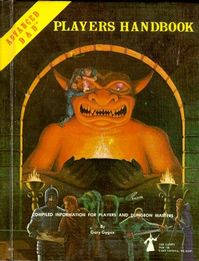 |
By Teague Bohlen
The First Edition of Advanced Dungeons & Dragons was hugely popular and a kick-ass fun time. It was also known as a numbers-heavy intellectual and imaginative exercise (which was why some parents and educators backed it as a hobby — even sponsored gaming groups in afterschool programs). The nature of the game was both abstract (no gameboard; play happens in your head, for the most part) and concrete (weird dice, many tables to consult, a massive and growing amount of rulesets, books, and supplements); so it’s only natural that some parts of the game would be, well, a bit cumbersome. Or, put another way, utterly nuts. (The effects of which could perhaps be rolled on the insanity-type table on page 83 of the DMG.)
It’s in the nature of the game that it was so convoluted–indeed, this was one of the things that made it so beloved. Understanding the game and its rules was something of a rite of passage. So it’s with no small affection that this list recounts some really poor decisions on the part of the game’s designers — Gary Gygax, Dave Arneson, and the whole gang. Because even the clunkers — sometimes especially the clunkers — have become somewhat legendary. Grab your 10-sided die and roll to see the least comprehensible rules that governed both dungeons and dragons.
10) Treasure Type
Speaking of random, Treasure Type lists have the opposite problem. This system of treasure placement suggests that every Gargoyle has 2-8 pieces of gold on them at all times, or that Shambling Mounds always have on their person an assortment of coin, a few gems, a couple of scrolls, and maybe a potion or miscellaneous magic item (not to mention that carrot they have for a nose, just in case you’re feeling snacky). Once players realized that this system was more or less a guarantee of at least a chance for a specific item type to drop, it becomes incentive to hunt them down. Who cares if nymphs are neutral good? She’s Treasure Type Q and X, man!
9) Level Titles
Okay, so these are pretty damn cool, and remain a fond memory for most players familiar with the 1st Edition rules. But if you think about it, they’re also pretty nuts — why is a 1st level fighter a veteran, if they’re first level? They’re even sort of insulting, in some cases. Take the Cleric titles: at sixth level, you’re a Catholic Canon; at seventh, you embrace Buddhism as a Lama; and at eighth, you’re a Patriarch out of the Greek Orthodox tradition. All this from a cleric who worships Odin. Seriously, this is just asking for religious boycotts. And while we’re talking about it, was there anyone who played a kick-ass Monk who wanted to go by the title “Grand Master of Flowers”?
8) Magic-Users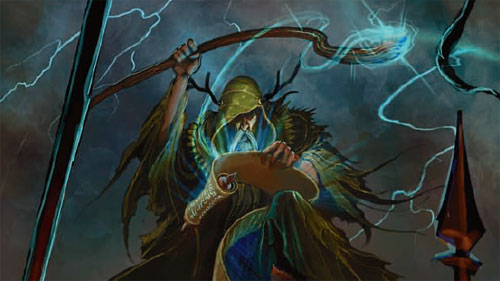
The name alone warrants inclusion on this list. Later editions fixed this — “mages” in 2nd Edition, “wizards” in 3rd. But really, anything was better than what they fixed upon for the 1st Edition. It becomes status quo for most players, but think about it–by this nomenclature, fighters (which had at least by this point graduated from the gender-exclusive and similarly lame class title of “fighting men”) should have been called “sword-users” and thieves would have been called “lockpick-users.” (I’m excluding clerics from this example, since they would have been called “healing-users with a blunt weapon of only marginal combat value”–which they already sort of were.) But the real beef about Magic-Users in 1st Edition was that in terms of magical combat, they were one-shot and done. One magic missile or sleep spell, and they were done for the remainder. Mages make up for this by being insanely powerful on the other end — when fighters are doing only slightly more damage per hit than they were doing at first level, mages can lay waste to an attacking platoon in a single round. But getting past that early going when a decent wand is more useful than you? That’s a tough row to hoe there, Gandalf.
7) Arbitrary Limits as to Gender, Race, and Class
Admittedly, this is a broad category. But the problem here is well represented in the early pages of the first edition Players Handbook, in which in his preface on page 6, Gary Gygax mentions that readers will find “no baseless limits arbitrarily placed on female strength”…and then two pages later, the rules specifically state that human female fighters are limited to no more than an 18/50 strength. (It can, of course, be argued that this can still be seen as consistent, and that Gygax meant that those limits — which are even more stringent, by the way, if your character is demi-human and not a fighter — are neither arbitrary nor baseless…but that only exacerbates the problem.) But seeing as how that score is (supposedly) rare, there are better examples: how about a cleric of Poseidon who can’t wield a trident? A dwarven fighter who can’t rise higher than 9th level? (And too bad for you if you wanted to be a half-elf cleric, because you couldn’t go higher than 4th level.) Why? Some of it is game mechanics — unlimited levels were one of the few perks that existed insofar as being a human was concerned, back then — and the game designers didn’t want magic-users and clerics using swords, so they just forbade it (and even though 3rd Edition and onwards has corrected this issue to some degree, it still lingers in legacy games like World of Warcraft.) But other things — like gender differentials for ability scores and the like? That’s not a game balance thing; that’s just alienating half your potential audience. To be fair, later editions of the game went too far the other way, and relied almost exclusively on the feminine pronouns — so the game switched from exclusionary to pandering. Great work.
6) Bards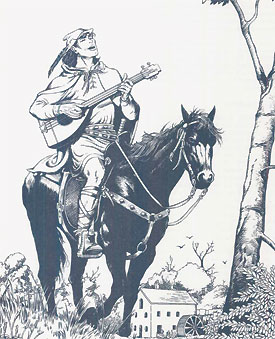
Holy crap, why was it so hard to be a bard in first edition? Any idiot can pick up a lute and start strumming it in a tavern — so why in the world would they need to be at least a fifth level fighter, a 5th level thief, and a first level druid before becoming a first level Rhymer? Especially in a game that didn’t seem to have been designed to support characters going much higher than 14th level or so? (No modules were created early on for levels above that with the exception of Isle of the Ape in 1985, and even though the spellcaster tables go up to 29th level, once most classes hit name level—10th, they stopped accumulating even full hit dice, let alone new powers or abilities.) Bards were effectively the first prestige class in a game system that didn’t yet support them. Bards–along with psionics and several items above–are a good example of why the stuff in the Appendices were relegated to the appendices in the first place.
—-
5) Nearly Anything in Unearthed Arcana 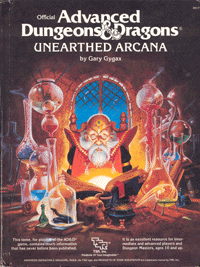
Sure, the cantrips were nice, and weapon specialization was popular with players, and already in-use in many campaigns — but the unbalanced “new” PC classes (mostly cribbed from Dragon Magazine), the new sub-races of elves (why play any elf but a grugach or drow anymore?) really embraced the new “risk-lite” era of gaming, in which munchkin-ism was an assumed part of the game, and characters being anything less than superhuman was unthinkable. UA also introduced the new format of most TSR products from there onwards; the half DM/half player supplement. Which obviously never worked. DMs couldn’t surprise players with the new info, since most of them obviously read the “for the DM’s eyes only!” material. There is no honor amongst thieves, nor amongst gamers when it comes to players trying to beat their DM.
4) God Stats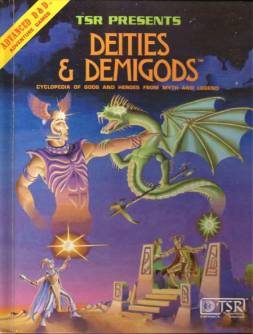
If you don’t want me to kill Loki, don’t tell me how many hit points he has. It’s as simple as that. Deities and Demigods went to great lengths in gaming-up pantheons (both real-life and fictional — including the Melnibonian, Nehwon, and Cthulhu mythoi that would be excised for copyright issues in the third printing), which was sort of cool–but giving the divine stats is really just begging for them to be used as high-level monsters. Which, it was constantly claimed by TSR, was not the point–though the fact that TSR’s own module Q1: Queen of the Demonweb Pits includes a climax in which it’s very possible (if not exceptionally easy) to kill Lolth herself makes this claim somewhat dubious. Later editions have had their cake and eaten it too in claiming that these stats aren’t the gods themselves, but their avatars on the material plane. Which is sort of cheating, but then again, so is claiming to have killed Zeus fair and square.
3) Material Components
Ah yes, the rule that turned all magic-users into ghoulish souvenir-hunters and gem-hoarders. This is one of those rules that some DMs used just to piss their players off–I mean, Identify is one of the most common spells cast by Magic-Users, and the material components are a 100gp pearl, and an infusion of an owl feather in wine with a miniature carp both swallowed whole. (Minature carp? Is that even a thing?) And at higher levels, the components get ridiculously expensive — Shape Change requires a jade circlet worth at least 5000gp, Duo-Dimension requires a similar ivory cameo of the caster worth 5000-10000 gp, and even the fifth-level Wall of Force requires a “pinch” of diamond dust. It’s pretty ridiculous, and with all the weird stuff that wizards would have to cart around for all their spells–gloves for the Bigby spells, balls of guano and sulphur for Fireballs, and rotten eggs for Stinking Cloud (you don’t really even have to cast the spell–just throw the damn egg) — it’s surprising that Magic-Users in D&D don’t come across more as the fantasy equivalent of cart-pushing bag ladies.
2) Encumbrance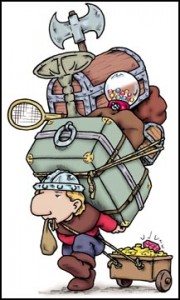
The ultimate rule that almost no one played with. There’s no denying that it makes sense — if you’re striving for realism, there’s no way that your character is carrying around much gold at all, especially if you’re a thief relying primarily on stealth and agility. And especially in that case, encumbrance rules are pretty generous. But still, they’re a pain, and most groups tended to fall in to one of three categories: those that ignored it completely, those that really only paid attention to it when it was egregious, and those that were granted a plethora of bags of holding in order to “realistically” be able to ignore it completely. And why? Because it’s a dumb, real-life rule that gets in the way of, you know, actually having fun. It’s the same reason most characters are still carrying around that one-week supply of iron rations, and generally don’t worry about food unless they’re in a tavern. It’s the same reason that there aren’t rules for potty breaks in the dungeon. It’s the same reason there’s not a table for seeing if you have a stiff neck from sleeping on a dungeon floor. Because it’s a game.
1) Grappling
This system has never
worked in the history of the game. Non-lethal combat — even just
grab-moves in weaponed combat — has always been a nightmare of a
process, in every edition. Which is a shame, because a good tavern
brawl should be easy to have. It would also be a pretty fun way to make
combat more interesting–instead of just trading blows, you could
actually grab that evil fighter by the hauberk and throw him across the
room. But no, it’s not so easy as just rolling to-hit. You have to
consult percentages charts, figure out how many increments of 10% your
strength is over 18, compare it to how many points over 14 your
opponent’s dexterity is, determine the kind of helmet your foe is
wearing (open-faced? nasaled but otherwise open? visored or slitted?).
And then, at some point in the process, you consult the “do you no
longer care about actually following through with this move?”
percentage on Table F.I.2: Loss of Interest. And if you’re like 99.9%
of the players who tried this, you eventually determine: “Ah, fuck it.
I swing my sword.”
